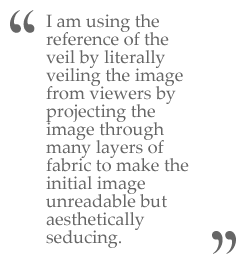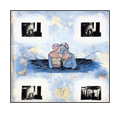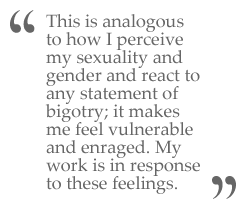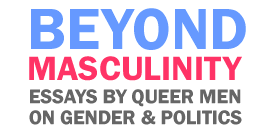|
The video projects an image of me nude from the shoulders up slowly spinning as
thin red threads bind my face and neck. The video begins with a few threads on
my face and over approximately six minutes they form large ribbon-like bands
over my eyes, mouth and neck, at this point the footage reverses and begins to
unbind me; It is meant to be seen as non-linear and perpetual. I chose to edit
the clips with very slow cross-fades in order to maintain the meditative feel of
the work and reduce the loop from two hours to twelve minutes.
To me gender is learned and not innate. The video references gender as a
performance by depicting the nature of the constraints of normative gender with
the slow building of the thread over time to completely deform and constrict my
face and neck. The looping shows how one can never truly escape these
constraints: first they appear invisible or inconsequential, but over time they
will build up until they completely conceal a person.
 While there are several potential reads for the function of the fabric
structure; I am most interested in it as a veil and in reference to
theatricality. The veil is currently a highly debated and controversial topic
with reference to the Islamic tradition of veiling women. To me the veil is an
overt symbol of oppression, a garment that binds and obscures. I hope to tap
into this debate and the possible reads of the veil. I am using the reference of
the veil by literally veiling the image from viewers by projecting the image
through many layers of fabric to make the initial image unreadable but
aesthetically seducing. I then invite the viewers to come inside the satin veil.
Once inside they are then confronted by a crisp and disturbing image of a person
being bound by thread. The harshness of the image is contrasted by the ethereal
nature of the large softer image being projected onto the chiffon lining. This
duality is important as it articulates the duality of what is perceived with
gender and what is experienced. While there are several potential reads for the function of the fabric
structure; I am most interested in it as a veil and in reference to
theatricality. The veil is currently a highly debated and controversial topic
with reference to the Islamic tradition of veiling women. To me the veil is an
overt symbol of oppression, a garment that binds and obscures. I hope to tap
into this debate and the possible reads of the veil. I am using the reference of
the veil by literally veiling the image from viewers by projecting the image
through many layers of fabric to make the initial image unreadable but
aesthetically seducing. I then invite the viewers to come inside the satin veil.
Once inside they are then confronted by a crisp and disturbing image of a person
being bound by thread. The harshness of the image is contrasted by the ethereal
nature of the large softer image being projected onto the chiffon lining. This
duality is important as it articulates the duality of what is perceived with
gender and what is experienced.
The reference of the theater, with the fabric alluding to a curtain, parallels
the concealing of the veil but speaks directly to the idea of gender as a
performance. This is also integral to the work because the clear image is
eventually revealed. In this way the connotations of the veil and the theater,
in reference to gender as performance, combine to make the potential
interpretation of the work more accurate to my intention.
A Foundation for Artistic
Practice: Discussion of Influences
  My discovery of David Wojnarowicz was the result of two important moments in my
life: coming out as queer, and making the decision to pursue being an artist. I
immediately became enthralled by his work and pored over it for months. His
writings are coarsely honest and his imagery complex and loaded with meaning.
The works that combined his writing and images became of particular interest to
me. For example “Untitled [One day this kid…]” is full of rage and hope. The
story is moving and the image of the innocent looking boy (a photograph of David
Wojnarowicz as a boy) surrounded by the text work together to produce a powerful
account of his life in a manner that reaches beyond mere autobiography. Above
all I value and carry with me his unapologetically personal approach to art
making. As Dan Cameron states: My discovery of David Wojnarowicz was the result of two important moments in my
life: coming out as queer, and making the decision to pursue being an artist. I
immediately became enthralled by his work and pored over it for months. His
writings are coarsely honest and his imagery complex and loaded with meaning.
The works that combined his writing and images became of particular interest to
me. For example “Untitled [One day this kid…]” is full of rage and hope. The
story is moving and the image of the innocent looking boy (a photograph of David
Wojnarowicz as a boy) surrounded by the text work together to produce a powerful
account of his life in a manner that reaches beyond mere autobiography. Above
all I value and carry with me his unapologetically personal approach to art
making. As Dan Cameron states:
He was a genuine idealist in the sense that he spoke up loudly for causes that
he believed in and never hesitated to make his art a vehicle for his political
convictions. But he was also a visionary artist in the sense that his works were
often triggered by private experiences or dreams, and he was especially fond of
creating links between ecstatic experience and polemical confrontation (Cameron,
3).
Wojnarowicz seemed to give me permission to speak loudly and never hesitate. I
began to create art that explicitly dealt with my personal experiences, often in
an overtly political way. Working this way was an extremely important step for
my work. I still work from personal experiences but have begun to move away from
being as aggressively political and as overtly autobiographical.
  The way I approach materials and object making mirrors that of Wojnarowicz. I do
not focus exclusively on aesthetics or issues and I use a variety of media as a
way to bring new layers of meaning and context to my work (Cameron, 4). However,
visually my work is very different from Wojnarowicz’s. This is especially true
in my more recent work where I have sought to have a very simple and elegant
aesthetic as opposed to Wojnarowicz’s complexly charged and emotionally raw
style. The way I approach materials and object making mirrors that of Wojnarowicz. I do
not focus exclusively on aesthetics or issues and I use a variety of media as a
way to bring new layers of meaning and context to my work (Cameron, 4). However,
visually my work is very different from Wojnarowicz’s. This is especially true
in my more recent work where I have sought to have a very simple and elegant
aesthetic as opposed to Wojnarowicz’s complexly charged and emotionally raw
style.
  Adrian Piper’s essay “The Joy of Marginality” speaks eloquently about passing as
mainstream, yet being marginal to it, and the perspective this relationship
provides (Piper, 236). I also attempt to utilize this privileged perspective in
my work to comment on the mainstream thought process. Although the source of my
marginality is due to being queer and not my ethnic identity, my awareness and
response corresponds with Piper’s. Adrian Piper’s essay “The Joy of Marginality” speaks eloquently about passing as
mainstream, yet being marginal to it, and the perspective this relationship
provides (Piper, 236). I also attempt to utilize this privileged perspective in
my work to comment on the mainstream thought process. Although the source of my
marginality is due to being queer and not my ethnic identity, my awareness and
response corresponds with Piper’s.
I become
aware of my racial identity when someone brings it to my attention. This
happens, for example, whenever someone makes a racist, sexist, homophobic, or
ethnic slur of any kind. That brand of irrational hostility, no matter where it
is explicitly directed, reminds me of my vulnerability as a black person (Piper,
233).
 This is analogous to how I perceive my sexuality and gender and react to any
statement of bigotry; it makes me feel vulnerable and enraged. My work is in
response to these feelings, as is Piper’s. This perspective affects my work
directly; I use this perspective to channel my experiences in productive ways
and to take back power in order to not be confined (Piper, 234). This is analogous to how I perceive my sexuality and gender and react to any
statement of bigotry; it makes me feel vulnerable and enraged. My work is in
response to these feelings, as is Piper’s. This perspective affects my work
directly; I use this perspective to channel my experiences in productive ways
and to take back power in order to not be confined (Piper, 234).
Beyond Piper’s writings, her interventionist performance based work and how it
functions is of great importance. In “The Mythic Being” she created an alter-ego
(a young black male) and walked around public places asserting this false
identity, reflecting the root of the discrimination she feels as a black female.
This speaks not only about racial discrimination, but can be read as showing
gender as performance. It is also of interest to my working method in that she
photographs these performances as documentation of the event and then through an
additive process uses that documentation to make an art object. Much of my work
is based in performance, and the photographs of the event are altered. These
alterations, such as the adding of thread to “Sewing the Façade,” turn the
documentation into autonomous art object... (continue reading)
| 



3 COMMENTS ON THIS ESSAY:
I love your art, especially the iconoclast images. Can I find them online elsewhere?
This type of art also highlights the similarities between devotion to religion and devotion to your partner, which I think is closer than a lot of people think.
simply stunning...:)
We are running a short feature of your art on www.redlimemagazine.com until Feb 4th
Your work is beautiful!